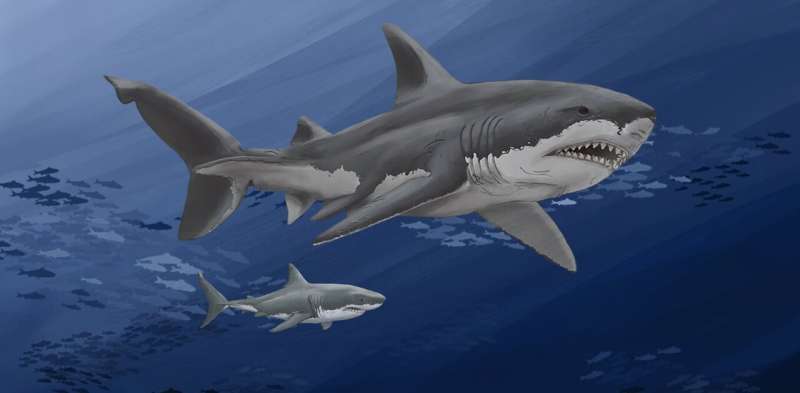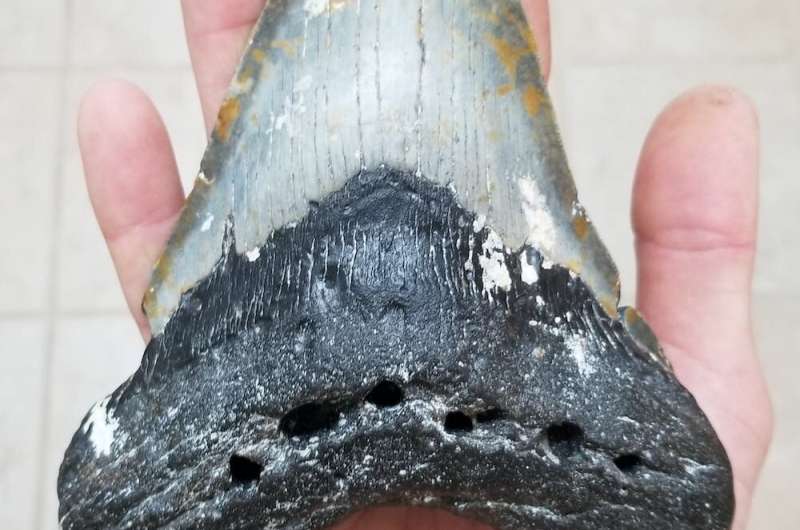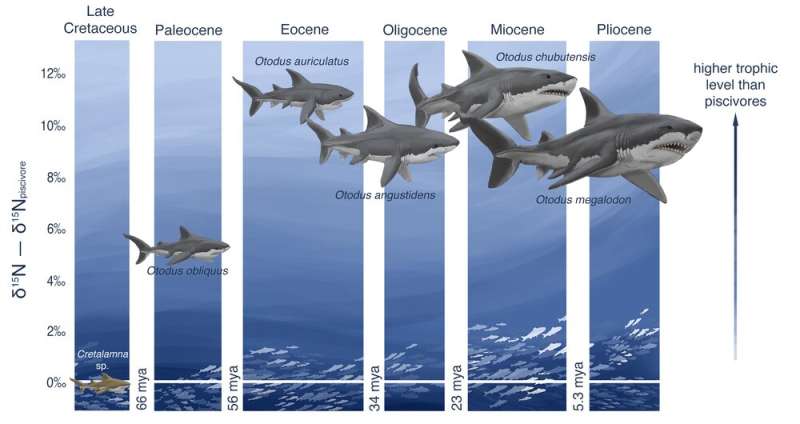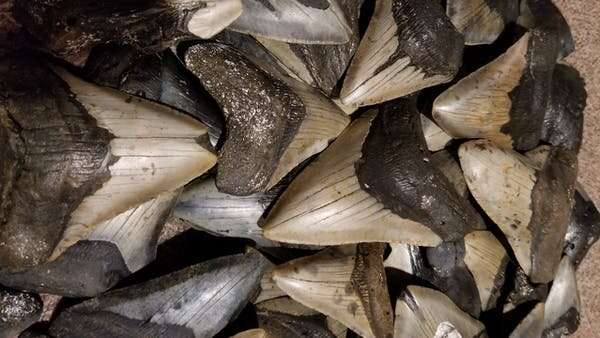[ad_1]

Tens of millions of many years ago, giant sharks three moments bigger than present-day fantastic whites stalked the world’s ocean. They’re extensive long gone now, but at times, another person walking on a beach front spots an odd triangular shape in the sand. On closer inspection, they understand it can be a fossilized tooth as significant as a human hand, with sharp serrated edges. And they have to marvel: What was that beast feeding on?
These fossilized enamel hold clues to a mystery about a legend of the seas, a mammoth creature that was at the apex of the foods chain—and then vanished.
It is really known as the megalodon, believed to be the most significant shark species to at any time exist. Evidence in the tooth and bite marks found on fossilized bones suggest these historical sharks were swimming the ocean between 23 million and 3.5 million years ago. Experts have believed they arrived at lengths upwards of 50 feet (15 meters)—longer than a city bus.
The megalodon was the previous species of a team of sharks called the megatooth sharks. We review the chemistry of fossils to far better understand ancient animals, and though quite a few mysteries remain about megalodon’s lifetime and eventual extinction, its tooth are revealing some responses.
What did ancient sharks take in?
There are tantalizing clues about the diet regime of historical sharks in the fossil record.
The form and framework of their tooth can suggest typical eating variations. Broad serrated megalodon tooth are believed to be especially well adapted to gnawing on marine mammals, even though the sharp and pointy enamel of other sharks lend them selves to piercing and tearing fish.

In some excellent situations, fossil maritime mammal bones have been located with the chunk marks of a megalodon. Some sperm whale bones have evidence of megalodon attacks on their foreheads, a component of the whale that would have been abundant in fat. Dolphin tailbones have also been found with deep megalodon tooth marks. Every single of these remarkable fossils presents a snapshot of one particular megalodon’s food on one day hundreds of thousands of several years back.
Were marine mammals a portion of megalodon’s normal diet program, or just a exclusive snack that day? And what else might have fallen prey to this massive shark?
Getting answers in the chemistry of fossil enamel
Utilizing freshly designed tools, we have been in a position to examine the chemical composition of these fossil enamel, together with samples from the United States, western Europe and Japan.
The effects, printed in two the latest scientific tests, explain to us about the food plan of each individual ancient shark and about the atmosphere it lived in prolonged right before humans walked the Earth.
When animals eat, they receive nutrients from their meals, which includes nitrogen and zinc. Since of this, nitrogen and zinc are handed up the meals website from prey to predator.
The two nitrogen and zinc have various stable isotopes, varieties whose atoms contain the very same quantity of protons but distinctive quantities of neutrons. For nitrogen, the ratio of the 15-nitrogen isotope to the 14-nitrogen isotope will increase with each stage up the food stuff website due to the fact animals are likely to discard additional of the 14-nitrogen isotope in their squander. On the other hand, the ratio of 66-zinc to 64-zinc decreases within animals higher up in the food items world-wide-web.
Very tiny quantities of nitrogen and zinc are preserved deep inside the mineral layers of fossil enamel. We can extract and purify these elements from the teeth, measure the isotope ratios, and then estimate the situation in the foodstuff website, for just about every ancient shark.
Although nitrogen isotopes are usually calculated in contemporary protein tissues, these decompose quickly and can not be measured in the fossil document. This new method of measuring nitrogen isotopes can evaluate the trace amount of nitrogen preserved in the mineral levels of fossil tooth around millions of several years. The zinc isotope strategy is also new this analyze marks the 1st time it has been utilized to sharks and fossils far more than 86,000 many years aged.
Alongside one another, the isotopes of nitrogen and zinc in fossil tooth inform us about the diet plan of extinct animals residing in ecosystems that vanished hundreds of thousands of several years ago. In our reports, we made use of nitrogen and zinc isotopes to reconstruct the weight loss plans of sharks.

Megalodon’s extinction: Level of competition with the white shark?
Knowledge the food plan of the megalodon can help us unravel the mystery of its extinction, and the probable ripple effects of its disappearance on maritime ecology.
Each measurements clearly show that the megalodon—and its a bit smaller sized megatooth ancestors—were feeding at an extraordinarily superior place in historic food stuff webs. In fact, at least in accordance to the nitrogen isotopes, they may possibly have been larger than any apex predator present right now.
To be in these a superior position they may well have been consuming now-extinct maritime mammals, such as predatory sperm whales. Megalodon may well also have been cannibalistic, it’s possible with more substantial grown ups consuming juveniles. It really is extremely likely that the megalodon was a real apex predator, not qualified as prey by any other marine animal.
The emergence of the fashionable white shark close to 5 million many years in the past has been hypothesized as a single element that could have contributed to megalodon’s extinction.

White sharks were considered to have fed on equivalent prey. There are similarities in tooth form, and fossil bite marks on comparable species also suggest that the white sharks may have outcompeted megalodon, or outcompeted juvenile megalodon.
The isotopes supply conflicting solutions. The comparison of nitrogen isotopes in between excellent whites and megalodon from all over the same time interval positioned these predators at distinctive positions in the food items website, this means that they were not competing for the similar prey. The zinc isotopes, however, do not reject the competition speculation, positioning these two sharks at comparable positions in the food world wide web as a substitute.
The disappearance of the large sharks could have been brought on by other factors, way too, this kind of as temperature improvements, the reduction of shelf environments owing to sea-amount fall, or, very likely, a combination of influences.
Long run investigation combining each procedures may possibly assistance take care of this conundrum and ultimately remedy the thriller of why the premier shark on Earth vanished.
Good white sharks could have contributed to megalodon extinction
The Conversation
This posting is republished from The Dialogue less than a Creative Commons license. Examine the original article.![]()
Quotation:
New analyses of large fossilized megalodon enamel are encouraging scientists unravel the thriller of their extinction (2022, July 21)
retrieved 27 July 2022
from https://phys.org/news/2022-07-analyses-huge-fossilized-megalodon-teeth.html
This document is topic to copyright. Apart from any fair working for the purpose of private analyze or investigate, no
part could be reproduced without having the written permission. The information is provided for details reasons only.
[ad_2]
Resource url


